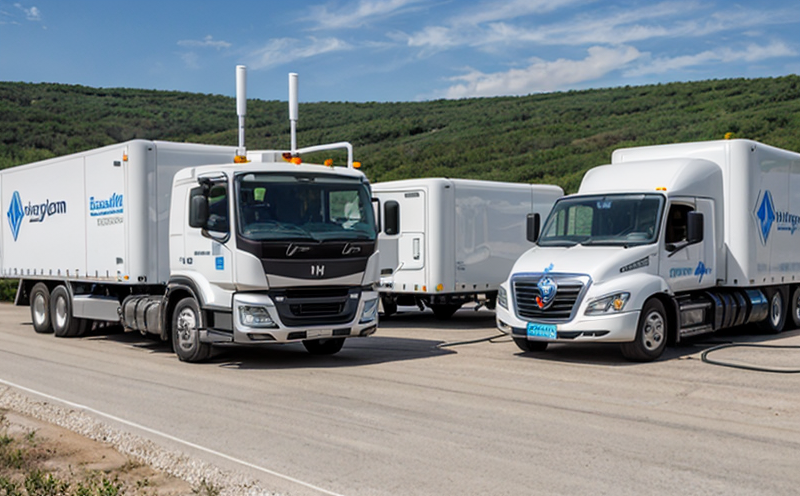EN ISO 11519 Hydrogen Fueling Pressure Testing
The EN ISO 11519 standard defines a comprehensive method for testing hydrogen fueling systems to ensure they meet the stringent requirements necessary for safe and reliable operation. This test is crucial for verifying that fueling systems can withstand high-pressure conditions without leaking or failing, which is essential in the rapidly expanding hydrogen fuel sector.
Hydrogen fueling pressure tests are particularly important as they help identify potential weaknesses in the design of the fueling system under extreme operating conditions. This ensures that hydrogen fueling stations meet regulatory requirements and can safely deliver compressed hydrogen to vehicles or other end-use applications.
The test procedure involves subjecting the fueling nozzle and connector assembly to a specified pressure, typically up to 70 MPa (10,000 psi), for a defined period. The system is then inspected for leaks or any signs of damage that could compromise safety during actual use.
This testing process plays a critical role in the development and certification of hydrogen fueling stations, particularly those designed to comply with international standards like EN ISO 11519. By ensuring compliance with these stringent requirements, testing laboratories can help manufacturers meet regulatory demands and build consumer confidence in the safety and reliability of hydrogen fuel infrastructure.
Quality managers and compliance officers tasked with overseeing the development and certification of hydrogen fueling systems will find this test particularly relevant as it directly impacts the safety and performance of hydrogen fuel stations. For R&D engineers, understanding the parameters involved in EN ISO 11519 testing is essential for optimizing system design and ensuring robustness.
Hydrogen fueling pressure tests are also crucial for procurement teams looking to source reliable equipment that meets international standards. By specifying compliance with EN ISO 11519, these stakeholders ensure that the equipment they purchase will not only meet regulatory requirements but also provide a safe and efficient means of hydrogen distribution.
- Why Choose This Test?
- Ensures safety in high-pressure fueling environments.
- Avoids costly failures during operational use.
- Maintains regulatory compliance for international markets.
- Provides confidence to end-users and consumers of hydrogen fuel systems.
Benefits
The benefits of EN ISO 11519 Hydrogen Fueling Pressure Testing extend across various stakeholders in the hydrogen fuel sector. For manufacturers, this test ensures that their products meet stringent international standards, thereby enhancing marketability and consumer trust.
Quality managers can rely on these tests to maintain consistent product quality and ensure compliance with regulatory requirements. Compliance officers benefit from having a clear pathway to ensure all components of the hydrogen fueling system are up-to-standard, reducing the risk of non-compliance penalties.
R&D engineers find this testing essential for optimizing design parameters and ensuring long-term performance under expected operating conditions. Procurement teams can confidently source equipment that meets the highest safety and reliability standards.
From a broader perspective, these tests contribute to the overall safety and efficiency of hydrogen fuel distribution networks. By identifying potential weaknesses in the system early on, these tests help prevent catastrophic failures that could endanger public safety or disrupt critical infrastructure.
Why Choose This Test
- Ensures Safety: The test verifies that fueling systems can withstand high-pressure conditions without leaking, ensuring safe operation in real-world scenarios.
- Avoids Costly Failures: By identifying potential issues early, this test helps prevent costly repairs or replacements during operational use.
- Maintains Regulatory Compliance: Ensuring that hydrogen fueling systems meet international standards like EN ISO 11519 is crucial for navigating market regulations and gaining access to international markets.
- Promotes Consumer Confidence: Reliable and safe hydrogen fueling infrastructure builds trust among end-users, which is vital for the acceptance of hydrogen as an alternative energy source.
International Acceptance and Recognition
The EN ISO 11519 standard has gained widespread recognition within the global hydrogen fuel sector. It is widely accepted by manufacturers, quality managers, compliance officers, R&D engineers, and procurement teams worldwide.
This international acceptance is due to its rigorous approach to ensuring safety in high-pressure systems. By adhering to this standard, stakeholders can demonstrate their commitment to best practices and regulatory compliance, which is increasingly important as the hydrogen fuel market continues to grow.
The EN ISO 11519 standard is referenced by various international standards organizations such as ISO, ASTM, and EN. This broad acceptance ensures that manufacturers, researchers, and procurement teams can rely on consistent testing criteria across different regions and markets.





